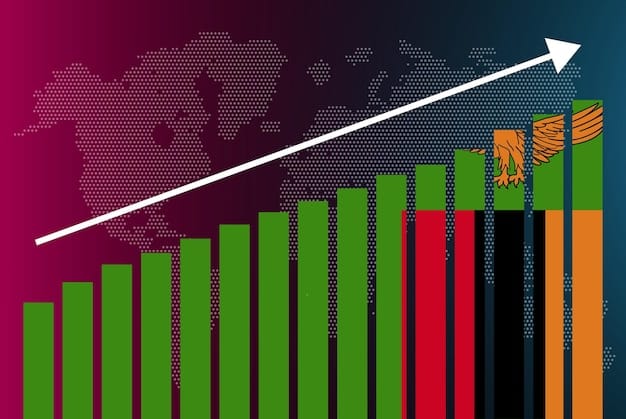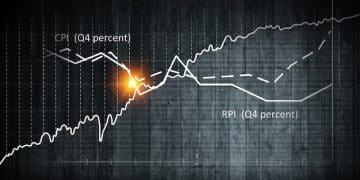Inflation Alert: Latest CPI Data’s Impact on Your Portfolio

The latest Consumer Price Index (CPI) data reveals crucial shifts in inflationary pressures, directly influencing monetary policy decisions and consequently shaping investment landscapes across various asset classes, requiring vigilant portfolio adjustments from investors.
Understanding the nuances of economic indicators is paramount for any investor navigating today’s complex financial landscape. The recent release of the Consumer Price Index (CPI) data serves as a critical beacon, offering insights into inflation’s trajectory and, more importantly, shedding light on Inflation Alert: How the Latest CPI Data Will Affect Your Portfolio. This report delves into the intricacies of current inflationary trends and their potential reverberations across your financial holdings.
Understanding the Consumer Price Index (CPI)
The Consumer Price Index (CPI) is a fundamental metric for assessing inflation, providing a comprehensive measure of the average change over time in the prices paid by urban consumers for a market basket of consumer goods and services. Its significance cannot be overstated, as it influences everything from interest rates to wage negotiations. A deeper dive into how this index is calculated and what its components represent is essential for any investor looking to make informed decisions.
The Bureau of Labor Statistics (BLS) meticulously collects price data for a wide array of goods and services, categorizing them into several major groups. These categories include food and beverages, housing, apparel, transportation, medical care, recreation, education and communication, and other goods and services. Each category contributes to the overall CPI, with housing often being the largest component due to its weighting.
Components of the CPI and Their Weighting
The CPI’s composition is carefully designed to reflect the typical spending patterns of urban consumers. Changes in the prices of different goods and services within this basket are weighted according to their importance in household budgets. For instance, housing costs, which include rent and owners’ equivalent rent, typically carry the heaviest weight, meaning fluctuations in this sector have a more significant impact on the overall index.
- Housing: Comprises rent, owners’ equivalent rent, and lodging away from home.
- Transportation: Includes gasoline, vehicle costs, public transportation fares, and car insurance premiums.
- Food and Beverages: Covers groceries, restaurant meals, and alcoholic beverages.
Understanding these weightings is crucial because it helps to explain why certain price movements might have a disproportionate effect on the headline CPI number. For example, a sudden surge in energy prices, particularly gasoline, can noticeably push up transportation costs, thereby contributing significantly to overall inflation.
Core CPI vs. Headline CPI
When discussing CPI data, it’s important to distinguish between headline CPI and core CPI. Headline CPI reflects the total inflation in the economy, encompassing all goods and services. Core CPI, on the other hand, excludes volatile items such as food and energy prices, which can fluctuate wildly due to seasonal factors or supply shocks. Economists often prefer to look at core CPI as a better indicator of underlying inflationary trends.
The rationale behind focusing on core CPI is that it provides a clearer picture of sustained price pressures, unclouded by temporary spikes or dips in food and energy costs. While headline CPI is what directly impacts consumers’ wallets on a daily basis, core CPI can offer a more stable guideline for policymakers when considering long-term monetary strategies. This distinction is vital for investors aiming to gauge the Fed’s potential reactions to the latest data.
Recent CPI Data Highlights and Analysis
The market has been eagerly awaiting the latest CPI data, and its release has certainly provided plenty of talking points for analysts and investors alike. A careful examination of these figures reveals a mixed picture of inflationary pressures, with some sectors showing signs of cooling while others remain stubbornly elevated. This nuanced scenario presents both challenges and opportunities for portfolio managers. It truly emphasizes the complexity underlying an Inflation Alert: How the Latest CPI Data Will Affect Your Portfolio.
Immediately following the data release, equity markets displayed volatility as investors digested the information. Bond yields also reacted, reflecting changing expectations about future interest rate movements. The dollar’s strength or weakness can also be influenced by CPI data, as it impacts global trade and capital flows.
Key Sectors Showing Price Increases
Notably, service sectors, particularly shelter and medical care, continue to show significant price increases. Shelter costs, driven by rising rents and owners’ equivalent rent, remain a persistent inflationary factor. This is often a slower-moving component of inflation, meaning its effects can linger even as other prices begin to stabilize. The persistently high cost of housing presents a substantial challenge for consumers and a focal point for economic policymakers.
- Shelter: Continues to be a primary driver, reflecting tight housing markets.
- Medical Care: Healthcare services and prescription drug prices contribute to upward pressure.
- Transportation Services: Airline fares and vehicle maintenance costs have also seen notable increases.
These service sector increases are particularly troublesome because they are often less responsive to interest rate hikes than goods prices. This means that taming inflation in these areas might require a more sustained period of restrictive monetary policy, potentially prolonging economic uncertainty. Their sticky nature implies that inflation could remain above target for longer than desired.
Areas of Deceleration or Deflation
Conversely, certain goods categories, particularly durable goods, have shown signs of price deceleration or even deflation. Used car prices, which had seen an extraordinary surge during the pandemic, have significantly eased. Apparel prices and some electronics have also contributed to the disinflationary trend in the goods sector. This rebalancing between goods and services inflation is a critical aspect of the current economic environment.
The supply chain disruptions that characterized the pandemic era have largely resolved, allowing for a more consistent flow of goods and alleviating some of the upward price pressures. This return to normalcy in goods pricing is a positive sign, indicating that some of the earlier inflationary impulses are indeed fading. However, whether this trend can fully offset the stickiness in service sector inflation remains to be seen.
Implications for Monetary Policy
The Federal Reserve’s primary mandate includes maintaining price stability, and the latest CPI data plays a crucial role in its monetary policy decisions. High and persistent inflation often prompts central banks to raise interest rates, aiming to cool down economic activity and reduce demand. The nuances within the CPI report – particularly the distinction between goods and services inflation – will inform the Fed’s next steps, dictating the overall economic climate for investors.
Central bankers analyze every facet of the CPI data, seeking to understand whether inflationary pressures are broad-based or concentrated in specific sectors. Their ultimate goal is to achieve an inflation rate of 2%, a target they believe is conducive to long-term economic growth and stability. Any deviation from this target necessitates careful consideration of policy adjustments.
Interest Rate Outlook
The latest CPI figures, especially if they show persistent core inflation, will likely reinforce the Federal Reserve’s stance on maintaining a restrictive monetary policy. This could mean either further rate hikes or a prolonged period of elevated interest rates. Investors should prepare for the possibility that the era of ultra-low rates may be behind us for a considerable time. The implications of this for borrowing costs and corporate earnings are significant.
A higher-for-longer interest rate environment impacts everything from mortgage rates to business investment. Companies facing higher borrowing costs may scale back expansion plans, potentially leading to slower economic growth. For consumers, higher interest rates mean more expensive debt, from credit cards to auto loans, which can dampen overall spending. This environment places additional pressure on businesses and households nationwide.
Potential for Quantitative Tightening (QT) Adjustments
Beyond interest rates, the CPI data also influences decisions regarding quantitative tightening (QT), where the Fed reduces its balance sheet by allowing bonds to mature without reinvestment. If inflation proves to be stickier than anticipated, the Fed might consider accelerating the pace of QT or maintaining it for a longer duration. This drains liquidity from the financial system, further tightening monetary conditions and impacting market dynamics.

Accelerated QT could lead to tighter financial conditions, pushing up long-term interest rates and potentially increasing market volatility. A larger supply of bonds in the market generally drives yields higher, influencing everything from corporate bond issuances to real estate financing costs. Investors need to be aware of how QT interacts with interest rate policy to fully grasp the Fed’s stance.
Conversely, signs of disinflation might give the Fed reason to pause or slow down QT, providing some relief to markets. The Fed is constantly balancing its dual mandate of maximum employment and price stability, and its decisions reflect this delicate trade-off. Their actions are highly data-dependent, making each CPI report a significant event for market participants.
Portfolio Adjustments in an Inflationary Environment
Understanding the impact of the latest CPI data on your portfolio requires a strategic approach. Inflation erodes purchasing power, making it crucial to position your investments to either preserve capital or even generate real returns in this challenging environment. An effective strategy recognizes which asset classes tend to perform well when inflation is elevated and adjusts accordingly. This is the core of navigating an Inflation Alert: How the Latest CPI Data Will Affect Your Portfolio.
The goal is not merely to avoid losses but to actively seek opportunities that may arise from changing economic conditions. Diversification remains key, but the specific allocation within that diversification needs to be re-evaluated. Considering alternative investments, beyond traditional stocks and bonds, may also become more appealing.
Equities: Sectoral Performance and Valuations
In an inflationary environment, not all equity sectors perform equally. Certain sectors tend to be more resilient or even thrive. Energy and materials sectors, for instance, often benefit from rising commodity prices, which are a direct component of inflation. Companies with strong pricing power – those that can pass on higher costs to consumers without significant loss of demand – also tend to fare better. Conversely, growth stocks, which rely heavily on future earnings, can be negatively impacted by higher discount rates. This can lead to a re-evaluation of their present value.
- Energy and Materials: Often perform well as commodity prices increase.
- Utilities and Consumer Staples: Can offer stable dividends and consistent demand.
- Financials: May benefit from rising interest rates, but also sensitive to economic slowdowns.
Valuations become even more critical when inflation is high. Overpaying for a stock, especially one with weak fundamentals or low pricing power, can expose investors to significant downside risk. A disciplined approach to valuation and a focus on companies with strong balance sheets and consistent free cash flow are paramount. Investors should also scrutinize earnings reports for signs of margin compression due to rising input costs.
Bonds: Yields, Duration, and TIPS
Bonds are particularly sensitive to inflation because their fixed payments lose purchasing power as prices rise. Higher inflation typically leads to higher bond yields as investors demand greater compensation for holding debt. This can result in declines in the value of existing bonds, especially those with longer durations. Investors holding long-term bonds might see the market value of their holdings decrease as interest rates climb in response to inflationary pressures.
To mitigate this, investors often favor shorter-duration bonds, which are less sensitive to interest rate fluctuations. Treasury Inflation-Protected Securities (TIPS) are another valuable tool because their principal value adjusts with the CPI, providing a built-in hedge against inflation. This makes them a compelling option when inflation is a primary concern. TIPS offer a guaranteed real return, making them unique in fixed income.
Real Assets and Commodities
Real assets, such as real estate and commodities, have historically served as effective hedges against inflation. The value of physical assets often keeps pace with, or even outpaces, rising prices. Real estate, for example, can see appreciation in value and rising rental income in an inflationary environment. Commodities like gold, silver, industrial metals, and agricultural products also frequently see their prices increase with inflation.
Gold, in particular, is often viewed as a traditional safe haven during times of economic uncertainty and inflation. Its value is not tied to any single currency or government policy, making it a reliable store of value. Investing in commodity-linked exchange-traded funds (ETFs) or directly in physical commodities can also provide exposure to this inflation-hedging strategy. These assets can help diversify a portfolio and protect against the erosion of purchasing power.
Long-Term Economic Outlook and Investor Sentiment
The current inflationary environment is not merely a short-term blip; it has significant implications for the long-term economic outlook and shapes investor sentiment for years to come. Understanding how these factors interrelate is crucial for developing a robust investment strategy. The interplay between inflation, economic growth, and the public’s perception of stability will largely determine market trajectories. This broader perspective helps contextualize the immediate insights from the Inflation Alert: How the Latest CPI Data Will Affect Your Portfolio.
Persistent inflation can lead to changes in consumer spending habits, business investment decisions, and ultimately, the overall growth potential of an economy. It can also influence wage negotiations, creating a potential wage-price spiral if not managed effectively. The challenge for policymakers is immense, as they try to steer the economy toward a soft landing without triggering a recession.
Impact on Consumer Spending and Business Investment
High inflation erodes consumer purchasing power, forcing households to prioritize essential spending and potentially reduce discretionary purchases. This shift can impact various sectors of the economy, particularly those reliant on consumer demand. Businesses, too, face challenges, including rising input costs and uncertainty about future demand.
This uncertainty can lead to a decrease in business investment, as companies become hesitant to undertake new projects or expand operations when future costs and revenues are unpredictable. Such a slowdown in investment can have long-term consequences for productivity growth and innovation. Government policies aiming to mitigate inflationary pressures often seek to balance the need for price stability with the imperative to support economic growth.
Investor Confidence and Market Volatility
Inflationary pressures and the associated monetary policy responses often contribute to increased market volatility and a notable shift in investor confidence. Uncertainty about the future path of interest rates and inflation can lead to more unpredictable market movements. When investors are unsure about the economy’s direction, they tend to be more cautious, potentially leading to capital flight from riskier assets to safer havens. This can lead to significant swings in equity, bond, and currency markets.

A sustained period of high inflation can shake investor confidence, as the real returns on investments diminish. This can prompt a re-evaluation of long-term financial goals and risk tolerance. Communicating policy intentions clearly and consistently is vital for central banks to manage expectations and temper market reactions. Their transparency can help instill a sense of stability, even amidst challenging economic data.
Moreover, the prospect of an economic recession, often a side effect of aggressive inflation-fighting efforts, can further dampen sentiment and lead to more defensive positioning in portfolios. Investors may prioritize capital preservation over growth, leading to shifts from equities to fixed income or money market funds. This defensive posture can persist until the economic outlook becomes clearer and inflationary pressures subside.
Strategies for Building a Resilient Portfolio
In light of ongoing inflationary pressures and the evolving economic landscape, building a resilient portfolio is more critical than ever. A resilient portfolio is one that can withstand market shocks and economic downturns, preserving capital and potentially generating returns regardless of the prevailing conditions. This involves a thoughtful articulation of an investment philosophy grounded in diversification, adaptability, and a long-term perspective. A well-constructed strategy helps mitigate the effects of an Inflation Alert: How the Latest CPI Data Will Affect Your Portfolio.
The goal is to not only weather the storm but also to identify and capitalize on opportunities that emerge. This often means moving beyond traditional asset allocation models and considering a broader range of investment vehicles. Flexibility is key, as economic conditions can change rapidly and unpredictably.
Diversification Beyond Traditional Assets
While traditional asset classes like stocks and bonds form the foundation of most portfolios, a truly resilient strategy embraces diversification beyond these conventional choices. Consider incorporating alternative investments that have a low correlation with traditional markets. These might include private equity, hedge funds, or even certain structured products designed to offer uncorrelated returns. The objective is to spread risk and reduce dependence on any single market segment.
- Real Estate: Direct ownership, REITs, or Crowdfunding platforms can offer exposure.
- Commodities: Gold, industrial metals, and agricultural products through futures or ETFs.
- Private Equity: Accessing growth companies outside public markets.
Furthermore, exploring international markets can provide additional diversification, as different economies may be in varying stages of the economic cycle. Investing in countries with stronger economic fundamentals or less inflationary pressures can help balance out domestic market risks. However, international investments also come with their own set of risks, including currency fluctuations and geopolitical instability, which must be carefully managed.
Rebalancing and Risk Management
Regular portfolio rebalancing is essential to maintain your desired asset allocation and risk profile. As market conditions change and certain assets perform better or worse, their weight in your portfolio will shift. Rebalancing involves selling some of the outperforming assets and reallocating funds to underperforming ones to bring the portfolio back to its target proportions. This disciplined approach helps lock in gains and buy assets at lower prices.
Effective risk management is also paramount. This includes setting stop-loss orders, using options strategies to hedge against downside risk, and maintaining a sufficient cash reserve for liquidity. Understanding your own risk tolerance and aligning your portfolio accordingly is a fundamental step. Avoid making emotional decisions based on market headlines; instead, stick to a well-researched, long-term plan. Reviewing your risk parameters periodically ensures they still align with your financial goals.
Adopting a Long-Term Perspective
Despite the short-term volatility and uncertainty, adopting a long-term perspective remains the cornerstone of successful investing. Economic cycles are a natural part of the market, and while inflation may be high now, it is unlikely to remain so indefinitely. Focusing on your long-term financial goals – whether it’s retirement planning, saving for a home, or funding education – helps you avoid overreacting to daily market fluctuations. This steady approach allows for a reduction in the typical stress that comes from an Inflation Alert: How the Latest CPI Data Will Affect Your Portfolio.
Compounding returns over time is a powerful force, and regular contributions to your investment accounts, even during turbulent times, can significantly boost your overall wealth accumulation. Maintaining patience and discipline, even when the financial news seems grim, often yields the best results. Professional financial advice can also be invaluable in navigating complex market conditions and ensuring your portfolio remains aligned with your objectives. It helps to have an expert guide you through the storms.
The Role of Economic Forecasting in Investment Decisions
In an environment defined by the “Inflation Alert: How the Latest CPI Data Will Affect Your Portfolio,” economic forecasting becomes an indispensable tool for investors. While no forecast is ever perfect, having an informed perspective on future economic trends can significantly enhance decision-making and help anticipate market shifts. This predictive capability allows investors to proactively adjust their portfolios rather than merely reacting to events.
Economic forecasting involves analyzing a myriad of data points, including CPI, employment figures, GDP growth, and global trade dynamics. These indicators, when viewed collectively, provide a more complete picture of the economic direction. Understanding the potential for recession, periods of growth, or prolonged inflationary pressures is crucial for strategic asset allocation.
Utilizing Various Forecast Models
Diverse forecasting models exist, each with its strengths and weaknesses. Some models focus on leading economic indicators, such as manufacturing new orders or building permits, which often signal future economic activity. Others employ econometric models that use statistical relationships between variables to predict outcomes. Many forecasters also incorporate qualitative factors, such as geopolitical events or policy changes, which, while harder to quantify, can have a profound impact. A wise investor will consider multiple perspectives, rather than relying on a single forecast.
For example, models predicting inflation might look at factors like money supply growth, wage growth, and global commodity prices. Recession forecasting models typically analyze inverted yield curves, consumer confidence, and corporate earnings. By reviewing a range of forecasts from reputable institutions and economists, investors can gain a more nuanced and balanced view of potential scenarios. This multifaceted approach helps in constructing resilient portfolios.
Adapting Strategies to Different Scenarios
A key benefit of economic forecasting is the ability to develop adaptive investment strategies for various potential economic scenarios. For instance, if forecasts suggest a prolonged period of high inflation, an investor might emphasize real assets, inflation-protected securities, and companies with strong pricing power. Conversely, if a recession is anticipated, a more defensive posture with an emphasis on stable, dividend-paying stocks and short-term bonds might be adopted. Flexibility is paramount in this dynamic environment.
Moreover, forecasting helps in identifying pivot points – times when economic conditions are likely to shift direction. These pivot points, such as the potential end of an interest rate hiking cycle, can present significant opportunities for rebalancing portfolios and taking advantage of emerging trends. Being prepared for these shifts, rather than being caught off guard, can make a substantial difference in investment performance. It is about being proactive, not reactive, which significantly improves the odds of success.
The Long-Term Impact of Inflationary Cycles
The current “Inflation Alert: How the Latest CPI Data Will Affect Your Portfolio” is not an isolated event but part of a larger economic cycle. Understanding the long-term impact of inflationary periods is crucial for investors, as these cycles can fundamentally alter the landscape of wealth creation and preservation. Historical data reveals patterns that offer valuable lessons for navigating present and future economic challenges. Inflationary cycles can reshape everything from consumer behavior to corporate strategy, dictating investment returns over extended periods.
Periods of high inflation often lead to a reallocation of capital, favoring assets that offer protection against rising prices. This shift can persist for years, affecting the relative performance of different asset classes. Recognising these long-term trends allows investors to position their portfolios not just for the immediate future, but for sustained financial health well into the future.
Historical Precedents and Lessons Learned
Examining historical inflationary cycles, such as the 1970s, offers invaluable insights. During that decade, persistently high inflation led to stagnant economic growth – a phenomenon known as stagflation. This period saw a significant underperformance of traditional equity and bond portfolios, while real assets like gold and real estate generally performed well. The lessons from these periods highlight the importance of active management and defensive positioning during inflationary times. It was a stark reminder of the corrosive power of uncontrolled price increases.
- 1970s Stagflation: Equity and bond markets struggled; real assets provided refuge.
- Post-WWII Inflation: Demand surge led to price increases, curbed by policy adjustments.
- Early 2000s Commodity Boom: Driven partly by global demand, increasing commodity-related inflation.
Another key takeaway is the role of central bank responses. Aggressive monetary tightening, while painful in the short term, eventually helps to bring inflation under control. However, this process often involves trade-offs, such as slower economic growth or even a recession. Learning from these historical responses helps investors anticipate current policy impacts and make more informed decisions about future market movements. The interplay between inflation and monetary policy is always a dance between control and response.
Adapting Investment Frameworks for the New Normal
The current inflationary environment may signal a shift from the low-inflation, low-interest-rate regime of the past few decades. Investors may need to adapt their investment frameworks to what could become a and potentially more volatile “new normal.” This means reassessing traditional asset allocations, reconsidering the role of fixed income, and placing a greater emphasis on inflation-hedging strategies. The rules of engagement may be changing, requiring a paradigm shift in investment thinking.
For instance, the “60/40” portfolio (60% stocks, 40% bonds), a staple for many decades, might need adjustments if both equities and bonds underperform simultaneously during inflationary periods. This could necessitate a greater allocation to alternative assets, commodities, or even private markets. Furthermore, companies that can innovate and maintain pricing power, regardless of the economic climate, will likely become even more valuable. Those with robust balance sheets and resilient business models are better positioned to weather the storm and emerge stronger.
| Key Point | Brief Description |
|---|---|
| 📊 CPI Breakdown | The latest CPI data reveals mixed signals with persistent service inflation but easing goods prices. |
| 🏦 Monetary Policy | Fed likely to maintain restrictive stance, possibly higher-for-longer rates and continued QT. |
| ➡️ Portfolio Impact | Reassess equity sectors, shorten bond durations, and invest in real assets like real estate and commodities. |
| 📈 Long-Term View | Anticipate continued volatility; adopt diversification, risk management, and a long-term investment horizon. |
Frequently asked questions about inflation and your portfolio
▼
Core CPI excludes volatile food and energy prices, offering a clearer view of underlying inflation trends. For investors, it helps differentiate between temporary price spikes and sustained inflationary pressures, influencing Federal Reserve policy decisions and thus market direction. Monitoring core CPI assists in making more stable, long-term investment decisions.
▼
Rising interest rates generally cause existing bond prices to fall because newly issued bonds offer higher yields, making older, lower-yielding bonds less attractive. Bonds with longer maturities are more sensitive to these changes. Investors often counter this by opting for shorter-duration bonds or inflation-protected securities like TIPS.
▼
During inflationary periods, sectors such as energy, materials, and consumer staples often perform well. Energy and materials benefit from rising commodity prices, while consumer staples companies can more easily pass on increased costs to consumers due to consistent demand for their essential products. Financials can also benefit from higher interest rates.
▼
Real assets, like real estate and commodities (e.g., gold, silver), are often considered strong hedges against inflation. Their value tends to increase alongside or even outpace rising prices, helping to preserve purchasing power. They provide tangible value, making them attractive investments when traditional assets might be struggling due to inflationary pressures.
▼
Diversification is crucial because inflation affects different asset classes unevenly. By spreading investments across various sectors, geographies, and asset types (including alternatives), investors can mitigate risks and potentially capture gains from areas that perform better during inflationary periods. This strategy minimizes the overall impact of individual asset underperformance.
Conclusion
The latest CPI data serves as a compelling reminder of inflation’s persistent influence on economic policy and investment strategies. As we navigate this dynamic financial landscape, understanding the nuances of price indices, their implications for monetary policy, and their direct impact on investment performance becomes indispensable. A proactive and adaptive approach to portfolio management, emphasizing diversification across traditional and alternative assets, rigorous risk management, and a long-term perspective, is more critical than ever. The journey through inflation may be uncertain, but informed decision-making remains the compass for wealth preservation and growth.





